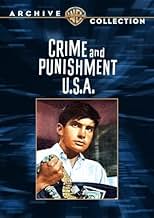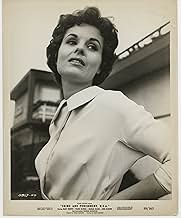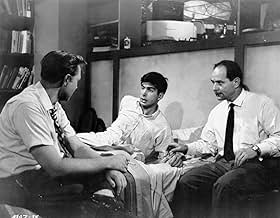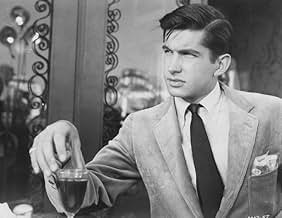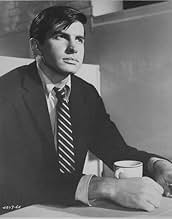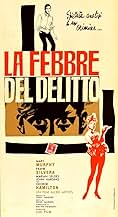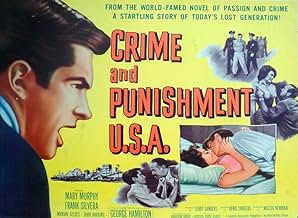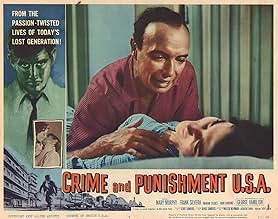Ajouter une intrigue dans votre langueA Californian law student murders a pawnbroker, then matches wits with the detective on the case.A Californian law student murders a pawnbroker, then matches wits with the detective on the case.A Californian law student murders a pawnbroker, then matches wits with the detective on the case.
- Réalisation
- Scénario
- Casting principal
- Nomination aux 1 BAFTA Award
- 2 victoires et 1 nomination au total
Tony Johnson
- Mrs. Cole
- (as Toni Merrill)
Sidney Clute
- Doctor
- (as Sid Clute)
James Hyland
- Man in Coffee Shop
- (as Jim Hyland)
Avis à la une
"Crime & Punishment, USA" updates Fyodor Dostoevsky novel to the 20th century and transports it from Saint Petersburg to Los Angeles. It wasn't the first film to do so, with a 1956 French adaptation and, before that, the American "Fear" (1946) is a "Crime and Punishment" picture in all but name; plus, another 1959 reworking also from France, Robert Bresson's "Pickpocket," took even more liberties with the text that it's, nonetheless, clearly inspired by. I'm not opposed to loose reworkings in the transmutation from prose to picture; indeed, "Pickpocket" is my favorite Dostoevsky film. Especially for a poor production such as this American counterpart, updating and transporting a narrative in adaptation makes a lot of economic sense. Moreover, it may lead to some interesting reinterpretations of the source that make it more relatable to modern times. Asking a low-budget 1959 film to adequately transcribe, say, the criticism of Russian nihilism from Dostoevsky's 19th century is a tall order and equally so for a general 1959 audience to understand. This film acknowledges that; plus, at least, it's evident that the filmmakers comprehended Dostoyevsky's story. Cleverly, they replaced the radicalism of Dostoevsky's era with some from their own--the Beat Generation.
Like Dostoevsky's protagonist Raskolnikov, the film's Robert murders a pawnbroker based on his philosophizing about his own supposed superiority (including in an article he penned), thus allowing him to flaunt the law in pursuit of allegedly benefiting humanity at large. Both characters' beliefs are of the sort of atheistic and counter-cultural order mocked by the conservative Dostoevsky. Thus, we see Robert play the bongos and even tap on his coffee cup before that. He doesn't wear turtlenecks and a fedora like a stereotypical beatnik, but I sense he thinks he's hip smoking a pipe instead of cigarettes like any upstanding 1950s American would. He's also unconcerned when the picture's Sonya type, renamed "Sally," admits her sexual promiscuity, but is upset with her prostitution because it's a self-sacrificing act that goes against his hedonistic thinking. A young George Hamilton looks the part, too. And, to top it off, we get a jazzy score.
I also like what is done with the Svidrigaïlov character, renamed "Fred." He's more vital here to Robert's redemption, unintended as it may be, whereas Sonya's "hooker with a heart of gold" was the underlying force behind that of Raskolnikov. Fortunately, Fred isn't the usual movie heavy as his counterpart was in the 1935 American adaptation, either. In the book, I found him to be one of the more amusing characters, and so he is here. I'm less fond of what is done with Sally. She's also something of a beatnik--what with the book of non-traditional spirituality in her room. She even sleeps with Robert right after he confessed the murder to her. She initially suggests that he turn himself in, but as quickly gives up on the idea. As with other adaptations, time is also given to the inspector interrogating the murderer, which is fairly well done here, although the 1935 French version remains probably my favorite handling of this character dynamic.
Unfortunately, the poor production values also lead to this appearing largely as a filmed play, with characters mostly talking in cramped flats. We don't see too much of Robert's Los Angeles, and he only briefly mentions the sort of wandering throughout the city that Raskolnikov did to consume much of the novel's substantial length. We also don't see the murder. And some of the sound effects are poorly done. Nevertheless, it does that one important thing right in updating its source to the Beat Generation. It's far from the best but also far from the worst version of the book I've seen.
Like Dostoevsky's protagonist Raskolnikov, the film's Robert murders a pawnbroker based on his philosophizing about his own supposed superiority (including in an article he penned), thus allowing him to flaunt the law in pursuit of allegedly benefiting humanity at large. Both characters' beliefs are of the sort of atheistic and counter-cultural order mocked by the conservative Dostoevsky. Thus, we see Robert play the bongos and even tap on his coffee cup before that. He doesn't wear turtlenecks and a fedora like a stereotypical beatnik, but I sense he thinks he's hip smoking a pipe instead of cigarettes like any upstanding 1950s American would. He's also unconcerned when the picture's Sonya type, renamed "Sally," admits her sexual promiscuity, but is upset with her prostitution because it's a self-sacrificing act that goes against his hedonistic thinking. A young George Hamilton looks the part, too. And, to top it off, we get a jazzy score.
I also like what is done with the Svidrigaïlov character, renamed "Fred." He's more vital here to Robert's redemption, unintended as it may be, whereas Sonya's "hooker with a heart of gold" was the underlying force behind that of Raskolnikov. Fortunately, Fred isn't the usual movie heavy as his counterpart was in the 1935 American adaptation, either. In the book, I found him to be one of the more amusing characters, and so he is here. I'm less fond of what is done with Sally. She's also something of a beatnik--what with the book of non-traditional spirituality in her room. She even sleeps with Robert right after he confessed the murder to her. She initially suggests that he turn himself in, but as quickly gives up on the idea. As with other adaptations, time is also given to the inspector interrogating the murderer, which is fairly well done here, although the 1935 French version remains probably my favorite handling of this character dynamic.
Unfortunately, the poor production values also lead to this appearing largely as a filmed play, with characters mostly talking in cramped flats. We don't see too much of Robert's Los Angeles, and he only briefly mentions the sort of wandering throughout the city that Raskolnikov did to consume much of the novel's substantial length. We also don't see the murder. And some of the sound effects are poorly done. Nevertheless, it does that one important thing right in updating its source to the Beat Generation. It's far from the best but also far from the worst version of the book I've seen.
In California, Robert Cole (George Hamilton) collapses in front of the cops. He buries the evidence of his crime, but a dying man may have seen him. He takes the man back home to Sally. He had written an article stating that certain superior people can break the law which comes to the notice of the police. He is brought in for an interview.
This opens on Pacific Ocean Park in Santa Monica. The most fascinating part of this B-crime movie may be the locations. It's great to see the old California with all the oil rigs. It does have a young George Hamilton as the lead. He's fine, but he's never been a great actor. I wanted this to start as a darker noir crime thriller. Robert should leave the man to die on the side of the road. That's the darker start. It's interesting that Robert has his views. Otherwise, the plot drags and I don't really care about him. This is not as compelling as it should be.
This opens on Pacific Ocean Park in Santa Monica. The most fascinating part of this B-crime movie may be the locations. It's great to see the old California with all the oil rigs. It does have a young George Hamilton as the lead. He's fine, but he's never been a great actor. I wanted this to start as a darker noir crime thriller. Robert should leave the man to die on the side of the road. That's the darker start. It's interesting that Robert has his views. Otherwise, the plot drags and I don't really care about him. This is not as compelling as it should be.
This is a well written script based on Dostoyevsky's "Crime and Punishment." I think it is essentially a remake of a French film, with Jean Gabin,called "Crime and Punishment," later changed to "The Most Dangerous Sin," made around the same time. At any rate, self- justification, remorse, rationalization, guilt, and Truth are the subjects at hand. Each is handled slowly, without emphasis; the viewer is expected to bring much to the picture. This explains the films lower ratings. Hamilton, as an actor, is weak, others have been reminded of Tony Perkins. He was too handsome, and wasn't smart enough to use make up or a cheap haircut to make himself appear to be the poor student of his role. But, the real star is Frank Silvera, who underplays the cagey Detective, and is a joy to watch in action. He toys with Hamilton, who, unfortunately, just isn't his match (as an actor.) Marian Seldes plays Hamilton's long suffering sister.
A young man murders an old woman for money, then relies on a sense of intellectual superiority to defeat an investigating detective.
A heavyweight subject like Dostoevski would be a challenge for the most experienced filmmaker. For the youthful crew here, however, it proves way too much. For one, Hamilton simply doesn't have the gravitas to bring off a convincing intellectual heavyweight, and that punches a hole right through the film's middle. But he's not the only one. Silvera's cagey detective makes those cat and mouse sessions with Robert (Hamilton) borderline parody. I don't know what director Sanders was telling him, but whatever it was, it didn't work. Ditto Harding's hammy wife killer that produces another regrettable result. Unfortunately, acting here means more than usual since there's so much loaded conversation. Only the two women, Murphy and Seldes, come off aptly.
On the other hand, the filmmakers certainly don't lack imagination. Adapting a bleak 19th- century Russian novel to the sunny climes of LA amounts to an imaginative undertaking, whatever the outcome. However, modifying a dense 1,000-page novel into a 70-minute screenplay would be a challenge for Dostoevski himself. Unfortunately, the effort here is like trying to pack 10 lbs. of weighty story into a 5 lb. leaky screenplay. All in all, I'm glad the Sanders brothers and Hamilton went on to more appropriate projects.
A heavyweight subject like Dostoevski would be a challenge for the most experienced filmmaker. For the youthful crew here, however, it proves way too much. For one, Hamilton simply doesn't have the gravitas to bring off a convincing intellectual heavyweight, and that punches a hole right through the film's middle. But he's not the only one. Silvera's cagey detective makes those cat and mouse sessions with Robert (Hamilton) borderline parody. I don't know what director Sanders was telling him, but whatever it was, it didn't work. Ditto Harding's hammy wife killer that produces another regrettable result. Unfortunately, acting here means more than usual since there's so much loaded conversation. Only the two women, Murphy and Seldes, come off aptly.
On the other hand, the filmmakers certainly don't lack imagination. Adapting a bleak 19th- century Russian novel to the sunny climes of LA amounts to an imaginative undertaking, whatever the outcome. However, modifying a dense 1,000-page novel into a 70-minute screenplay would be a challenge for Dostoevski himself. Unfortunately, the effort here is like trying to pack 10 lbs. of weighty story into a 5 lb. leaky screenplay. All in all, I'm glad the Sanders brothers and Hamilton went on to more appropriate projects.
To begin with, I almost did not acquire this when I chanced upon it, since the film does not have much of a reputation; even so, it has recently been released on DVD-R as part of Warners' "Archive Collection", running 96 minutes (like the version I watched) rather than 78 as listed on the IMDb! In any case, the result is undeniably gripping (given the source material) and decidedly accomplished (in spite of the obvious low budget) – with gleaming cinematography by Floyd Crosby and a jazzy score by Herschel Burke Gilbert.
Best of all, the performances (notably, as always, the arrogant protagonist and his wily nemesis) are reasonably impressive. George Hamilton (being nominated for a BAFTA award in his film debut) kind of channels Anthony Perkins here, and it is unfortunate that he would soon forsake such thoughtful roles for sophisticated (and, in the long run, superficial) ones. Frank Silvera plays his pivotal cop role as something of a buffoon; Mary Murphy's character, then, does not shy away from discussing her sordid 'profession'; while John Harding appears as the seducer of the hero's sister. Incidentally, Hamilton's scenes with the latter two are only slightly less compelling than his confrontations with Silvera (established in previous cinematic renditions as the novel's centerpiece).
As the title suggests, Dostoyevsky's morality tale has been updated to modern-day America: curiously, it eschews the pivotal figure of the pawnbroker entirely (though we are still told why the murder was committed) – indeed, the narrative here starts off with the arrest of the painter! Still, the victim's essentially disagreeable characteristics are transferred onto the afore-mentioned Harding – which seemed unnecessary at first, but this does generate an intriguing complicity between the two murderers paid off, most effectively, in ironical fashion when the student ultimately confesses because he believes the other fellow killed himself out of remorse when it was over rejection!
In the end, the film is pretentious (boasting a powerful script by Walter Newman), with a tendency towards sleaze; that said, this mature approach is quite redolent of the transitional period in which it was made – being entrenched somewhere between studio-system Hollywood and the 'movie brats' generation. For the record, this was also director Sanders' first effort, of whose later work I have watched (and own) WAR HUNT (1962), ELVIS: THAT'S THE WAY IT IS (1970/2000) and INVASION OF THE BEE GIRLS (1973); besides, I have just acquired THE American WEST OF JOHN FORD (1971; TV) and am interested in ONE MAN'S WAY and SHOCK TREATMENT (both 1964).
Best of all, the performances (notably, as always, the arrogant protagonist and his wily nemesis) are reasonably impressive. George Hamilton (being nominated for a BAFTA award in his film debut) kind of channels Anthony Perkins here, and it is unfortunate that he would soon forsake such thoughtful roles for sophisticated (and, in the long run, superficial) ones. Frank Silvera plays his pivotal cop role as something of a buffoon; Mary Murphy's character, then, does not shy away from discussing her sordid 'profession'; while John Harding appears as the seducer of the hero's sister. Incidentally, Hamilton's scenes with the latter two are only slightly less compelling than his confrontations with Silvera (established in previous cinematic renditions as the novel's centerpiece).
As the title suggests, Dostoyevsky's morality tale has been updated to modern-day America: curiously, it eschews the pivotal figure of the pawnbroker entirely (though we are still told why the murder was committed) – indeed, the narrative here starts off with the arrest of the painter! Still, the victim's essentially disagreeable characteristics are transferred onto the afore-mentioned Harding – which seemed unnecessary at first, but this does generate an intriguing complicity between the two murderers paid off, most effectively, in ironical fashion when the student ultimately confesses because he believes the other fellow killed himself out of remorse when it was over rejection!
In the end, the film is pretentious (boasting a powerful script by Walter Newman), with a tendency towards sleaze; that said, this mature approach is quite redolent of the transitional period in which it was made – being entrenched somewhere between studio-system Hollywood and the 'movie brats' generation. For the record, this was also director Sanders' first effort, of whose later work I have watched (and own) WAR HUNT (1962), ELVIS: THAT'S THE WAY IT IS (1970/2000) and INVASION OF THE BEE GIRLS (1973); besides, I have just acquired THE American WEST OF JOHN FORD (1971; TV) and am interested in ONE MAN'S WAY and SHOCK TREATMENT (both 1964).
Le saviez-vous
- AnecdotesThe opening aerial shots are of Pacific Ocean Park in Santa Monica, CA, a popular amusement park in the 1960s that has since closed down.
- ConnexionsReferenced in Hollywood Mouth 3 (2018)
Meilleurs choix
Connectez-vous pour évaluer et suivre la liste de favoris afin de recevoir des recommandations personnalisées
Détails
- Durée1 heure 36 minutes
- Couleur
- Mixage
Contribuer à cette page
Suggérer une modification ou ajouter du contenu manquant

Lacune principale
By what name was Crime & Punishment, USA (1959) officially released in India in English?
Répondre
